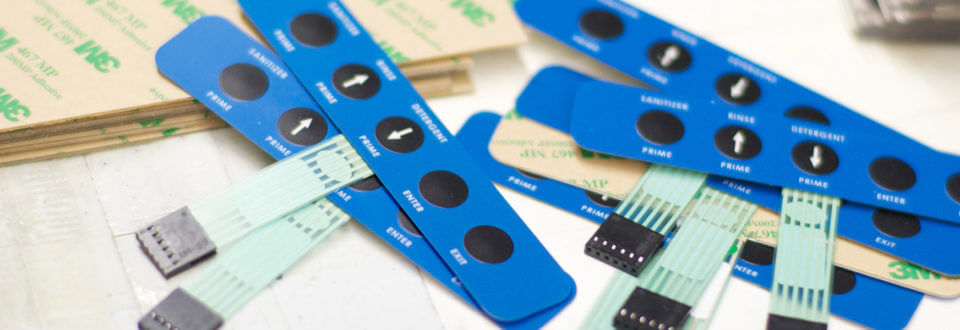Understanding Membrane Switches: The Secret to Trusted and durable Controls
Membrane changes represent a vital aspect of modern-day interface layout, mixing functionality with resilience in various applications. These flexible elements not just help with customer communication however are additionally crafted to stand up to the roughness of demanding atmospheres, from clinical devices to industrial machinery. Understanding their building and construction, procedure, and the myriad advantages they provide is necessary for designers and developers alike. As we discover the intricacies of membrane layer buttons, it comes to be clear that their duty in improving control systems is both profound and complicated, raising questions about exactly how best to utilize their capabilities in future technologies.
What Are Membrane Layer Switches?
Membrane layer switches are a sophisticated solution in the realm of interface modern technology, integrating capability and design flawlessly. These tools offer as a user interface between customers and digital systems, integrating numerous components right into a portable layout. Generally constructed from flexible, slim layers of materials, membrane layer buttons are made to reply to touch, enabling individuals to engage with equipment and electronic tools efficiently.
The key components of a membrane switch include a published circuit layer, graphic overlay, and a spacer layer that protects against unintended activation. The graphic overlay can be customized to mirror brand identity or individual choices, enhancing appearances while making certain use. Membrane switches are generally made use of in various applications, including clinical tools, customer electronic devices, and commercial equipment, owing to their toughness and resistance to ecological elements such as wetness and dirt.
Among the key advantages of membrane layer buttons is their ability to endure wear and tear, making them ideal for high-traffic settings. In addition, they are light-weight and call for very little room, permitting ingenious layouts in item advancement. In general, membrane changes stand for a useful and efficient choice for modern digital user interfaces, marrying innovation with user-centric design concepts.

How Membrane Changes Job
The operation of membrane switches over hinges on an easy yet effective system that translates individual input into digital signals. These switches include numerous layers, generally including a visuals overlay, a spacer layer, and a circuit layer. When a user presses the button, the leading layer warps, allowing a conductive aspect in the circuit layer to reach an equivalent conductive pad on the bottom of the visuals overlay. This contact closes the circuit and sends out an electronic signal to the tool, suggesting that the switch has actually been triggered.
The design of membrane layer switches can differ, but they typically include domes or responsive components to supply responses to the customer, enhancing the overall experience. The products made use of in membrane layer switches, such as polyester or polycarbonate, add to their durability and resistance to environmental variables, consisting of wetness and dirt. Furthermore, the published circuits are normally encapsulated, which secures them from wear and tear over time.

Benefits of Membrane Layer Switches
One of the primary benefits of membrane buttons is their convenience in layout, enabling them to be personalized to satisfy certain individual needs and visual needs. This versatility encompasses different industries, where various forms, dimensions, and colors can be utilized to improve customer interaction and aesthetic allure.
Furthermore, membrane great post to read switches are recognized for their durability. Built from robust materials, they are immune to dust, wetness, and physical wear, which substantially expands their life-span compared to traditional mechanical buttons. This longevity makes them especially appropriate for high-traffic atmospheres and applications requiring long life.

Additionally, membrane switches provide a structured profile, leading to a thinner style that can be integrated into different gadgets without adding mass. This function not only improves the aesthetic charm but likewise adds to a more ergonomic product layout.

Applications of Membrane Layer Buttons
Functional and user-friendly, membrane layer switches locate applications throughout a broad range of markets, consisting of medical gadgets, customer electronics, and commercial devices. In the clinical area, these switches are indispensable to devices such as diagnostic devices, individual surveillance systems, and infusion pumps, where integrity and convenience of cleaning are essential. Their ability to maintain and hold up against rough settings capability makes them excellent for such applications.
In customer electronic devices, membrane layer buttons are made use of in products like microwaves, cleaning devices, and remote controls - membrane switch. Their smooth design permits user-friendly interface, enhancing the general customer experience while providing resilience and resistance to tear and use
Industrial equipment additionally benefits from membrane layer switches, especially in control panels for equipment and automation systems. These buttons offer protection versus dirt and wetness, making certain constant efficiency in challenging atmospheres. Furthermore, their customizable features allow manufacturers to tailor them to details operational requirements, enhancing effectiveness and capability.
Selecting the Right Membrane Layer Switch
When picking a membrane button, it is vital to consider various factors that affect performance and suitability for details applications. The primary considerations include ecological problems, tactile responses, toughness, and layout specs.
First, evaluate the operating atmosphere; switches exposed to dampness, chemicals, or severe temperature levels require specific materials to make sure durability go to my blog and performance. Next off, review the need for responsive feedback. Depending upon user communication, some applications may gain from a responsive feedback to verify activation, while others might choose a non-tactile style for aesthetic factors.
Resilience is one more essential aspect; membrane switches need to be designed to stand up to constant use, effects, and abrasion. Ensure the picked switch can withstand the expected lifecycle, particularly in high-usage circumstances.
Conclusion
Finally, membrane switches over work as important elements in the style of long lasting and trustworthy control systems across various markets. Their small layout, integrated with durable construction and personalized features, boosts user interaction while making sure longevity in demanding environments. The adaptability of membrane switches enables customized remedies that see this meet specific operational requirements, reinforcing their significance in contemporary technology. membrane switch. As markets remain to advance, the significance of incorporating efficient membrane button remedies can not be overemphasized.
Membrane switches represent a critical element of contemporary user interface layout, mixing functionality with resilience in different applications.Membrane buttons are a sophisticated remedy in the world of customer interface modern technology, combining performance and design perfectly. Usually built from versatile, thin layers of materials, membrane buttons are designed to react to touch, allowing individuals to engage with machinery and digital tools successfully.
The design of membrane buttons can differ, but they commonly incorporate domes or responsive aspects to give feedback to the user, boosting the total experience.In conclusion, membrane switches serve as vital parts in the layout of sturdy and trusted control systems across numerous industries.